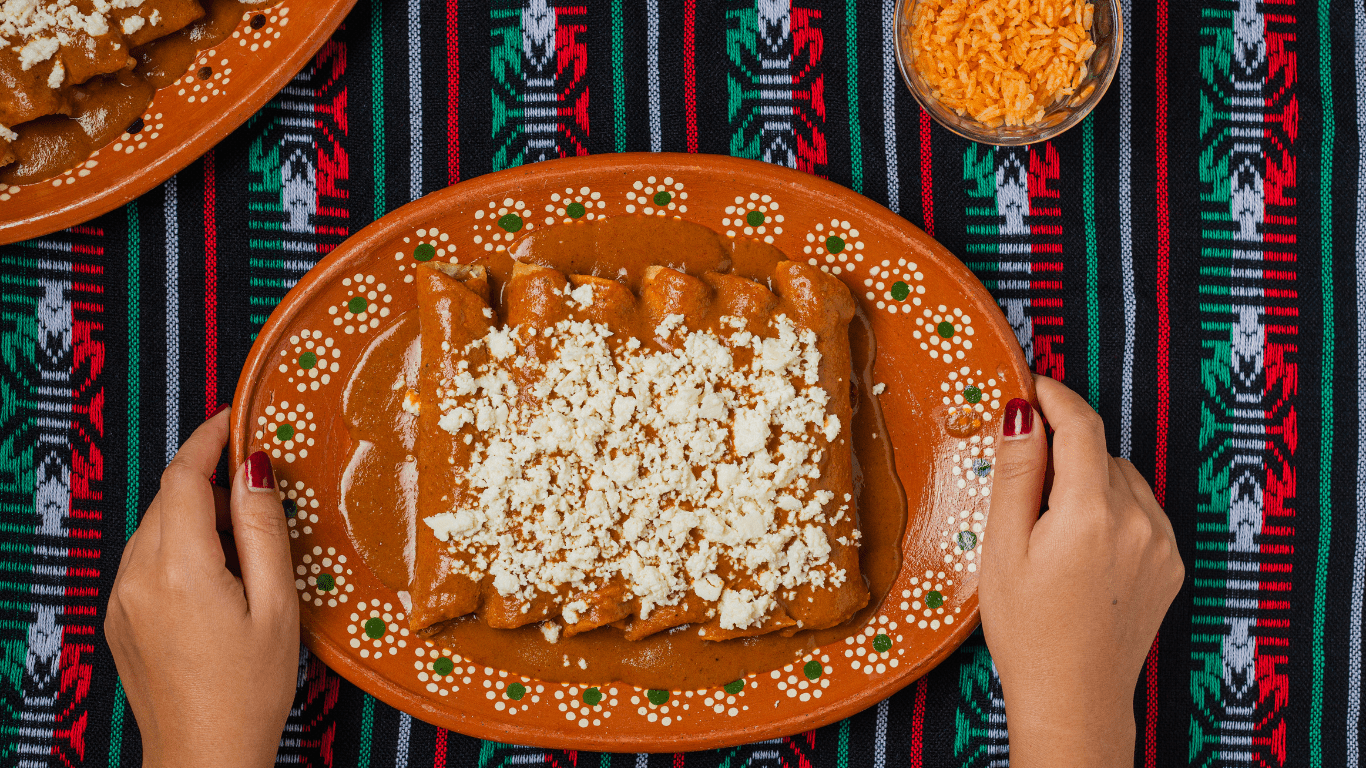History and Origins of Pipian Mole
Pipian Mole, also known as “green mole” or “mole verde,” is one of the oldest and most traditional types of mole in Mexican cuisine. Unlike its more famous cousin, Mole Poblano, which is dark and chocolate-based, Pipian Mole is a lighter, green-colored sauce made primarily from pumpkin seeds (pepitas). This dish has deep roots in Mesoamerican cultures, dating back to the pre-Hispanic period when indigenous peoples like the Aztecs and Mayans used pumpkin seeds in their cooking for both their flavor and nutritional value.
The name “Pipian” is derived from the Nahuatl word for seed, “pipitz.” The sauce itself is believed to have originated in central and southern Mexico, particularly in the regions of Oaxaca, Puebla, and Tlaxcala. Pipian Mole was traditionally used in religious ceremonies, offering a connection between the food, the gods, and the people who prepared and consumed it. Over time, the dish evolved, incorporating new ingredients brought by the Spanish during colonization, but its fundamental base of pumpkin seeds has remained the same.
Ingredients and Recipe for Pipian Mole
The simplicity and earthiness of Pipian Mole make it a beloved dish, and the recipe can vary slightly depending on the region. However, its essential elements include:
 Pepitas (pumpkin seeds): These are the foundation of the sauce, providing a creamy texture and rich, nutty flavor.
Pepitas (pumpkin seeds): These are the foundation of the sauce, providing a creamy texture and rich, nutty flavor.
 Tomatillos: They give the mole its signature green hue and add a tangy brightness to the sauce.
Tomatillos: They give the mole its signature green hue and add a tangy brightness to the sauce.
Green chiles: Jalapeños, serranos, or poblano peppers are commonly used to introduce a mild to medium heat level.
Cilantro: This herb infuses the sauce with a fresh, herbal quality.
Garlic and onion: These aromatics are key in building the flavor profile of the mole.
Epazote or hoja santa: These herbs are traditionally used in Mexican cooking for their distinctive flavor.
Spices: Cumin, coriander, and sometimes allspice or cinnamon can be added for depth.
Chicken or vegetable broth: Used to thin the sauce and give it a silky consistency.
Recipe:
- Toast the pumpkin seeds: In a dry skillet, lightly toast the pepitas until they are golden brown and begin to pop. Be careful not to burn them as this can make the sauce bitter.
- Blend the green ingredients: In a blender, combine tomatillos, cilantro, green chiles, garlic, and onion. Blend until smooth.
- Grind the toasted pumpkin seeds: After the pepitas have cooled, grind them in a food processor or blender until they form a fine powder.
- Cook the sauce: In a large saucepan, heat some oil over medium heat and add the tomatillo mixture. Cook for 10-15 minutes, stirring occasionally, until it thickens slightly.
- Add the ground pepitas and broth: Slowly stir in the ground pumpkin seeds and the broth, and simmer the mixture for another 15-20 minutes until it reaches a thick, creamy consistency.
- Season and serve: Add salt, pepper, and spices to taste. Pipian Mole is traditionally served over chicken, pork, or vegetables, often accompanied by rice and tortillas.
Cultural Significance
Pipian Mole holds a cherished place in Mexican culinary traditions, often featured in celebrations, family gatherings, and religious events. Its deep connection to Mesoamerican history makes it a dish that resonates with cultural pride, representing the fusion of indigenous and colonial influences that define Mexican cuisine today.
In many Mexican homes, Pipian Mole is served during important life events, such as baptisms, weddings, and holidays like Día de los Muertos (Day of the Dead). It is a symbol of community and family, a dish that brings people together to share food and stories. The communal preparation of the mole is just as important as the meal itself, reflecting the deep-rooted tradition of hospitality and collaboration in Mexican culture.
The use of pepitas in the dish also highlights the resourcefulness of ancient Mesoamerican societies, who used every part of the plant, from the seeds to the flesh, in their cooking. Today, Pipian Mole continues to be celebrated for its unique flavor and versatility, often appearing in both traditional and modern Mexican restaurants.
Regional Variations of Pipian Mole
While the basic ingredients of Pipian Mole remain the same, regional variations add a unique twist to the dish. For example, in Oaxaca, chefs may add hoja santa, a fragrant herb that enhances the sauce’s earthy flavor. In Puebla, the sauce may be thickened with tortillas or masa, creating a heartier version of the dish.
Additionally, while green Pipian Mole is the most common, there is also a red version, which uses dried red chiles instead of green ones, giving it a spicier, smokier flavor. This red Pipian is often paired with turkey or duck and is a popular dish during festive occasions.
Modern Uses and Adaptations
In recent years, chefs and home cooks have begun experimenting with Pipian Mole, incorporating it into creative and contemporary dishes. The sauce’s versatility means it can be used as a base for enchiladas, drizzled over grilled vegetables, or even served with seafood like shrimp or fish.
In modern Mexican-American cuisine, Pipian Mole has found its way into fusion dishes that blend traditional Mexican ingredients with global culinary trends. From Pipian Mole tacos to Pipian Mole flatbreads, this ancient sauce is being reimagined for new generations of food lovers.
Moreover, Pipian Mole has become a popular choice for cooking workshops and team-building events, where participants can learn about its history and cultural significance while enjoying the hands-on experience of making the dish. Its rich history, combined with its simple preparation, makes it an ideal dish for culinary exploration.
Top choices for Pipian Mole
Pipian Mole is a versatile sauce that pairs well with a variety of dishes, from meats to vegetables. Its nutty, earthy flavor and creamy texture make it a fantastic accompaniment to both traditional and modern recipes. Here are some of the best things to use Pipian Mole with:
1. Enchiladas
Pipian Mole enchiladas are a delicious way to incorporate the sauce. Simply fill the tortillas with your choice of meat (like chicken or pork) or vegetables, then smother them in the mole sauce before baking. Topping with crumbled queso fresco and fresh cilantro adds extra layers of flavor and texture.
2. Tamales
Tamales with Pipian Mole filling or simply topped with the sauce are another traditional and tasty combination. Whether the tamales are filled with chicken, pork, or even cheese and vegetables, Pipian Mole adds a rich and flavorful dimension.
3. Empanadas
Empanadas filled with shredded chicken, pork, or vegetables can be served with Pipian Mole as a dipping sauce or even drizzled on top. The crispy exterior of the empanadas contrasts nicely with the smooth, rich mole.
4. Tacos
Use Pipian Mole as a topping for tacos. Fill the tacos with grilled meats, vegetables, or beans, then drizzle the mole on top. Add fresh toppings like onions, cilantro, and radishes for a delicious combination of textures and flavors.
5. Beans
Serve Pipian Mole with black beans or pinto beans for a hearty vegetarian or vegan meal. The sauce adds richness and complexity to the simple flavor of the beans, creating a nutritious and filling dish.
Pipian Mole: The Perfect Recipe for a Collaborative Team-Building Event
What makes Pipian Mole such an excellent choice for team-building?
- Cultural Enrichment: Introducing employees to Pipian Mole fosters appreciation for Mexican traditions, promoting diversity and inclusion within the workplace. These aspects are increasingly important to modern workforces.
- Hands-on Engagement: Team members actively collaborate, measure ingredients, and cook together. The process of cooking Pipian Mole is simple enough to ensure that everyone, regardless of cooking skill, can participate and enjoy the activity.
- Social Interaction: As employees cook, they naturally converse and share stories, which leads to stronger personal connections. It’s an organic way to build relationships, whether done in person or remotely.
- Delicious Results: At the end of the workshop, participants get to enjoy the fruits of their labor. Sharing a meal, even virtually, is a timeless way to connect, celebrate, and bond with others.
Reinforcing Company Culture and Employee Well-being
Workshops like Pipian Mole are not just fun—they help reinforce a company’s culture by showing employees that they are valued. Employees who feel their employer cares about their personal development and well-being are more likely to remain loyal and productive. As Gallup found, businesses with higher engagement levels experience 41% lower absenteeism and 40% fewer quality defects.
By integrating interactive, culturally rich experiences into the workplace, companies can create environments where employees feel seen, heard, and valued. This helps mitigate the effects of disengagement and builds a stronger, more resilient workforce.
How Pipian Mole Fits into a Broader Engagement Strategy
Implementing a successful team-building strategy requires more than just one-off events. Companies that aim to foster long-term engagement should incorporate consistent and varied activities into their employee engagement programs. While Pipian Mole workshops may be a standout event, it’s essential to follow up with additional opportunities for employees to connect and grow.
For example, companies could organize:
- Monthly cooking workshops that explore cuisines from around the world.
- Virtual happy hours where teams can unwind and share their culinary creations.
- Charity cooking events where employees prepare meals for those in need, combining team-building with giving back to the community.
By rotating and diversifying team-building experiences, companies can sustain employee engagement and prevent burnout. Virtual and hybrid options also provide the flexibility needed to cater to both remote and in-office staff, ensuring inclusivity across the board.
The Future of Team-Building: Virtual Cooking Workshops as a Retention Tool
In an increasingly digital workplace, virtual and hybrid team-building workshops are not a passing trend—they’re the future. As companies adapt to new working models, they must prioritize the employee experience, especially when engagement is at an all-time low. Pipian Mole workshops offer a perfect blend of cultural enrichment, teamwork, and fun, making them an ideal tool to reignite employee engagement.
Gallup’s surveys show the importance of addressing disengagement head-on. Companies that do so will not only boost productivity and profitability but also create workplaces where employees thrive.
By investing in unique and memorable team-building experiences like Pipian Mole cooking workshops, companies can help their employees reconnect, rediscover their passion for work, and feel valued in their roles. The result? A happier, more engaged, and more productive workforce.








